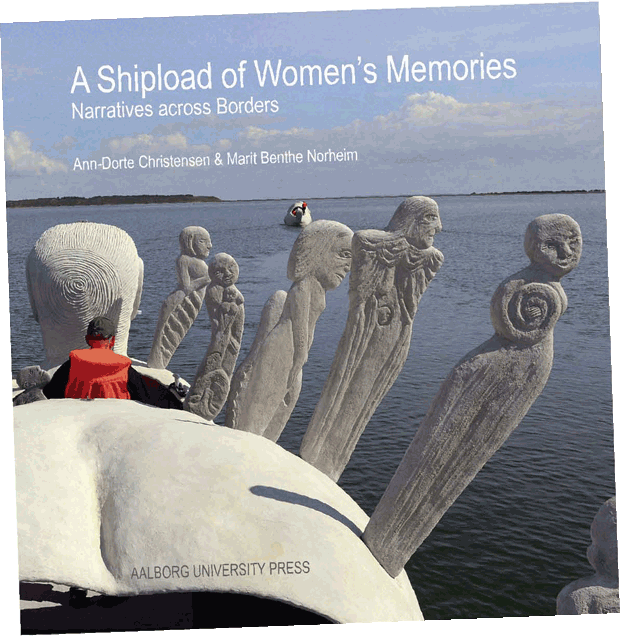
A Shipload of Women’s memories
Narratives across Borders
“The work on which this book is based represents true synergy between creative sociological analyses and sculptural imagination and skill. Each element in itself would be a remarkable contribution. Together, the authors have crafted something remarkable from older women’s life stories and narratives of border crossing and diversity.”
Professor Ann Phoenix, University College London and University of Helsinki.
This book is based on 18 life stories as told by women over the age of 70 with roots in 27 different countries. Each story is analysed as a unique account of individual experiences with strength, pain and love. The stories are, at the same time, a source of knowledge about major events in society over the past decades where flight, migration and encounters between different cultures have been a condition of life for many.
Visual artist Marit Benthe Norheim’s project, Life-boats, is the framework for this book, which consists of three sailing sculptures that symbolize different stages in women’s lives: Longing – the young about to set out in life; Life – the pregnant in mid-life; Memories – the ageing. It is the third boat and its 19 fi gureheads that this book is linked to.
The narratives of the fi gureheads hold the common message – in spite of their differences – to remember the past and to use those experiences to promote openness and tolerance.
This book is based on a collaboration between Professor Ann-Dorte Christensen, Aalborg University, and visual artist, Marit Benthe Norheim. Journalist, Marianne Knudsen, has contributed to the research and the interviews. The book is published with support from the Spar Nord Foundation.
BOOK REVIEW, A Shipload of Women's Memories
Published in the European Journal of Women's Studies, the most prominent European journal for gender research.
Reviewed by Serbian researcher Zorana Antonijevic, University of Novi Sad, Serbia.
Extract from the review:
As in all memory work, the interaction between researchers and researched brings challenges in maintaining intimacy, openness and empathy in situations in which many experiences (migration, war and violence) are not usually shared. However, the life stories collected in the book aim to present not only the present situation of some of the women, such as 79-year-old asylum seeker Basma from Syria (pp. 64–66), but also to
build understanding and open-mindedness between cultures in order to prevent future conflicts. Therefore, the book can serve as a learning tool for tolerance, inclusion and diversity in a world torn by violence, exclusion and differences
A Shipload of Women’s Memories: Narratives across Borders is a remarkable and utstanding book, well researched, well written and accessible beyond the narrow circle of academics. I would strongly recommend it not only to students of social sciences or gender studies, feminists and visual artists but to anyone interested in learning about our societies and the ways in which diversity and dialogue can connect us in resisting intolerance, violence and war.
Great BOOK REVIEW from Oxford University Press, of A Shipload of Women's Memories
From Oxford University Press, migration studies, written by Kathy Davis, who is a highly recognized
gender research journalist and editor of the European Journal of Women's Studies, the most
recognized gender research magazine in Europe.
Extract from the review:
The book shows how traveling across borders can also be enriching as long as connections are maintained with families and cultures. More generally, the stories of the interviewed women indicate how mobility can promote an understanding of differences and help develop tolerance within cultures, more generally.
This book is a good illustration of what contemporary social theory on mobility might gain from a biographical perspective. We clearly need theoretical frameworks that attend to the ways migrants, often with great creativity, manage the apparent contradictions of belonging and not belonging, while finding ways to live viable lives ‘in-between’ cultures. And, finally, the addition of Norheim’s reflections as an artist on the women’s stories provides insight into the emotional dimension of belonging in ways that a straightforward sociological analysis cannot. She used her impressions of the interviewed women to create a figurehead that would capture the essence of their life story
The book is, therefore, an example of how the use of imagination, empathy, and creativity necessary for producing an artwork that can enhance the narrative approach favored by biographical researchers. A Shipload of Women’s Memories. Narratives across Borders is a ‘must-read’ for anyone
interested in migration, mobility and displacement; gender and its intersections of age,class, ethnicity, and national belonging; and life-stories as methodology. It offers a memorable journey into the lives of some extraordinary women. And, last but not least, it will leave readers longing to see the Life-boats for themselves, as they continue on their voyages throughout Europe.



